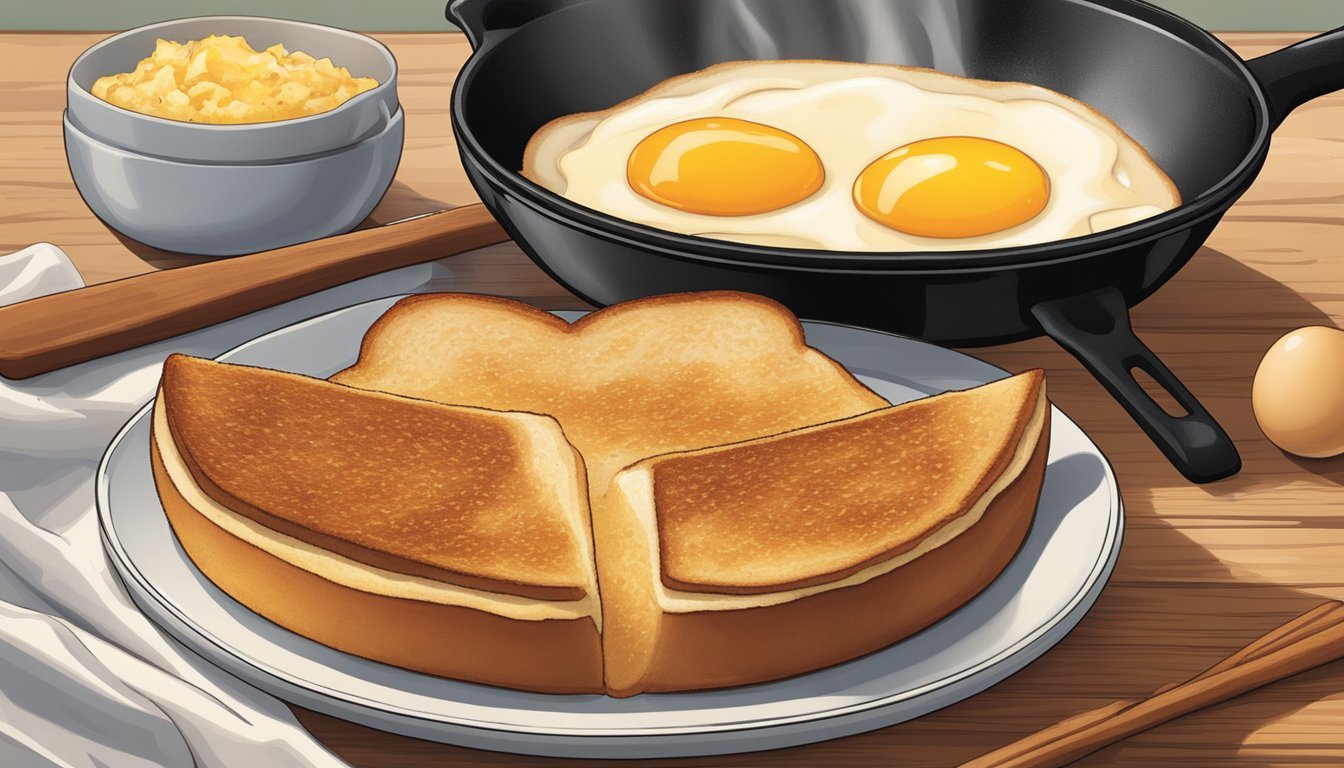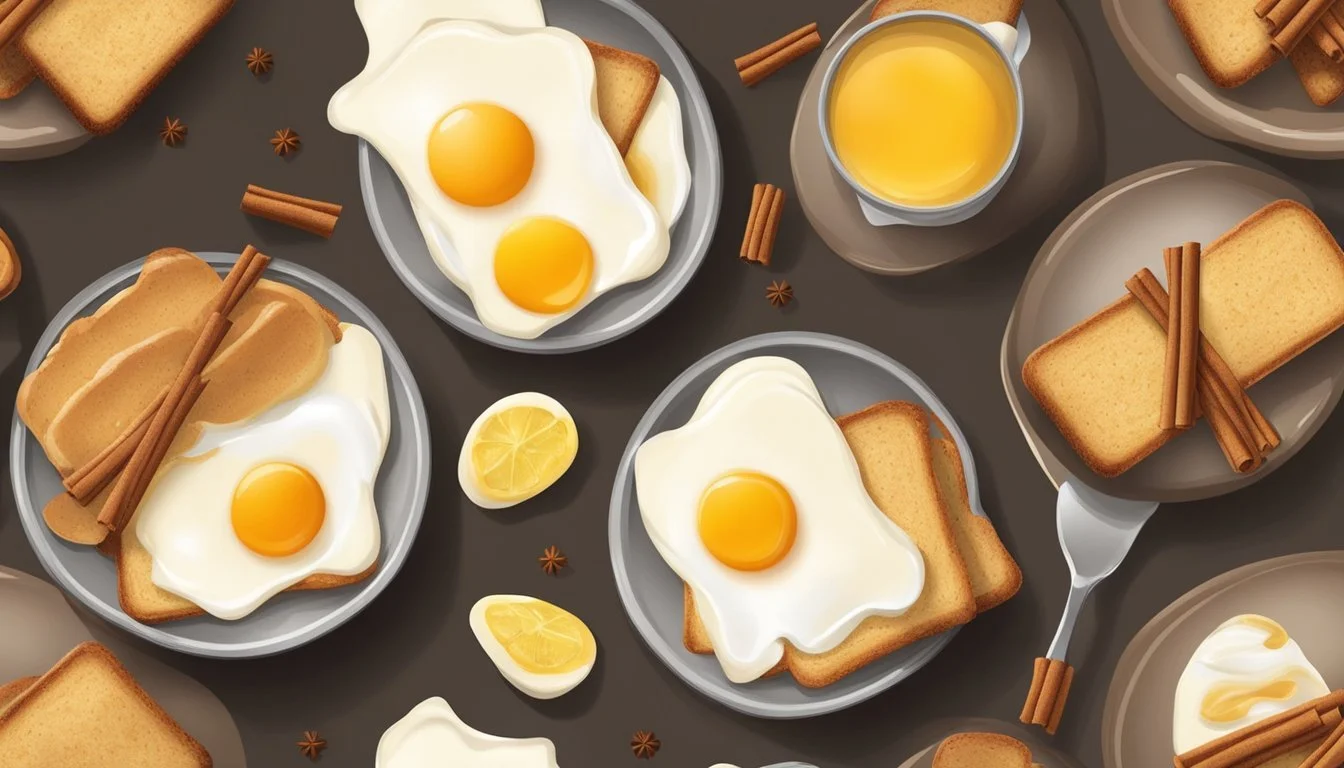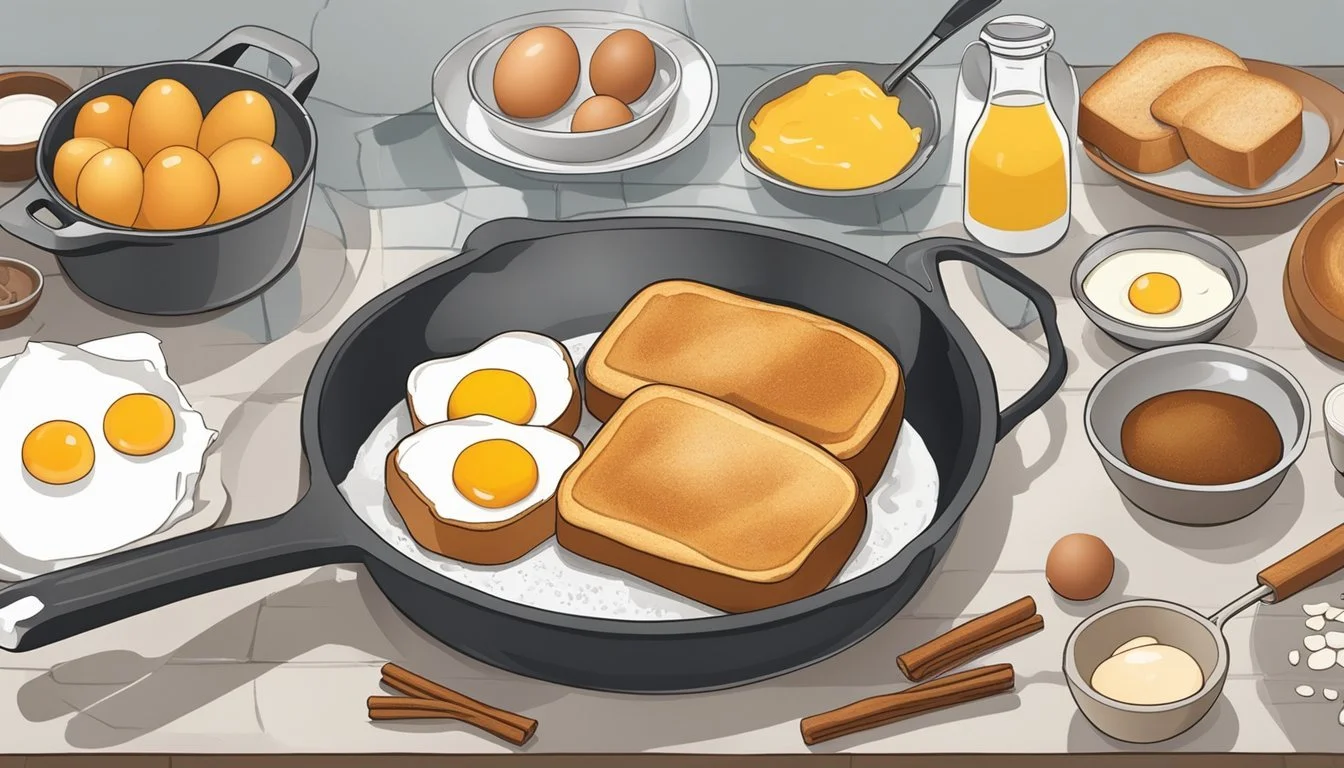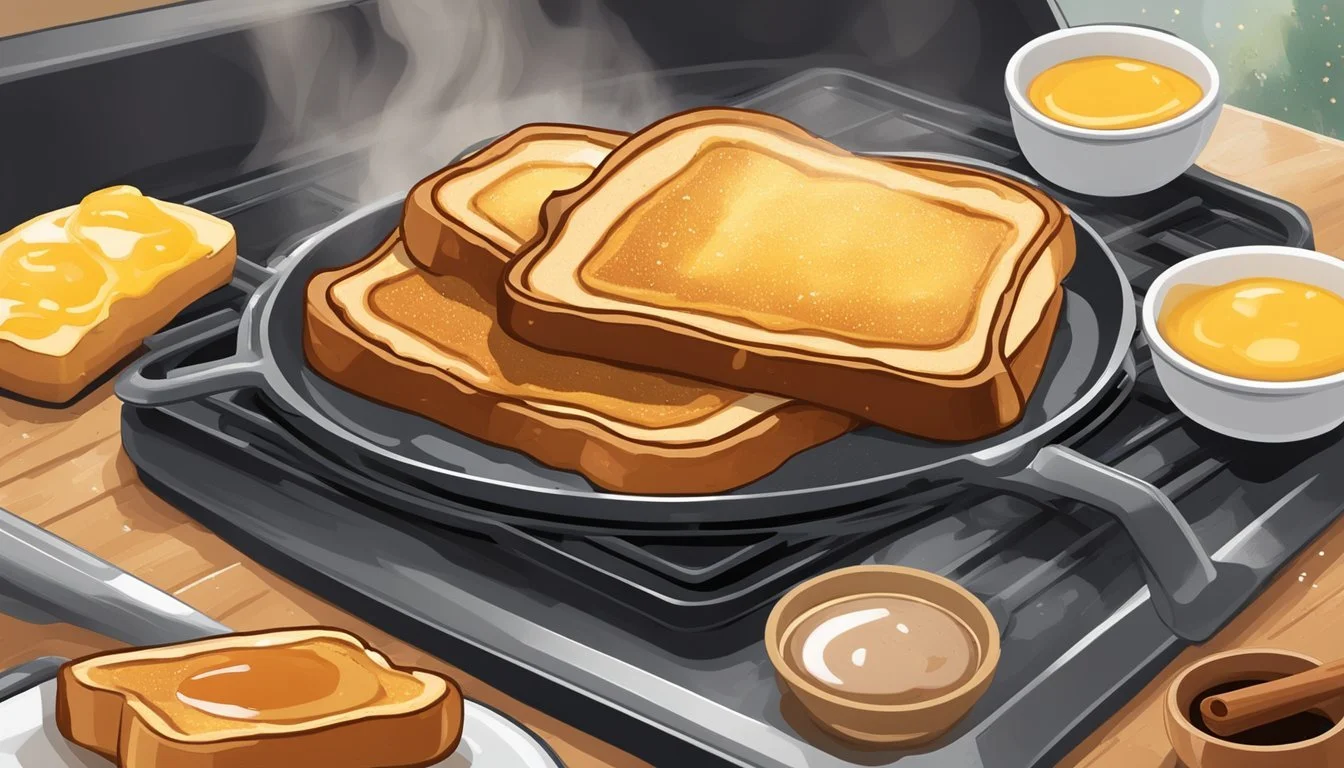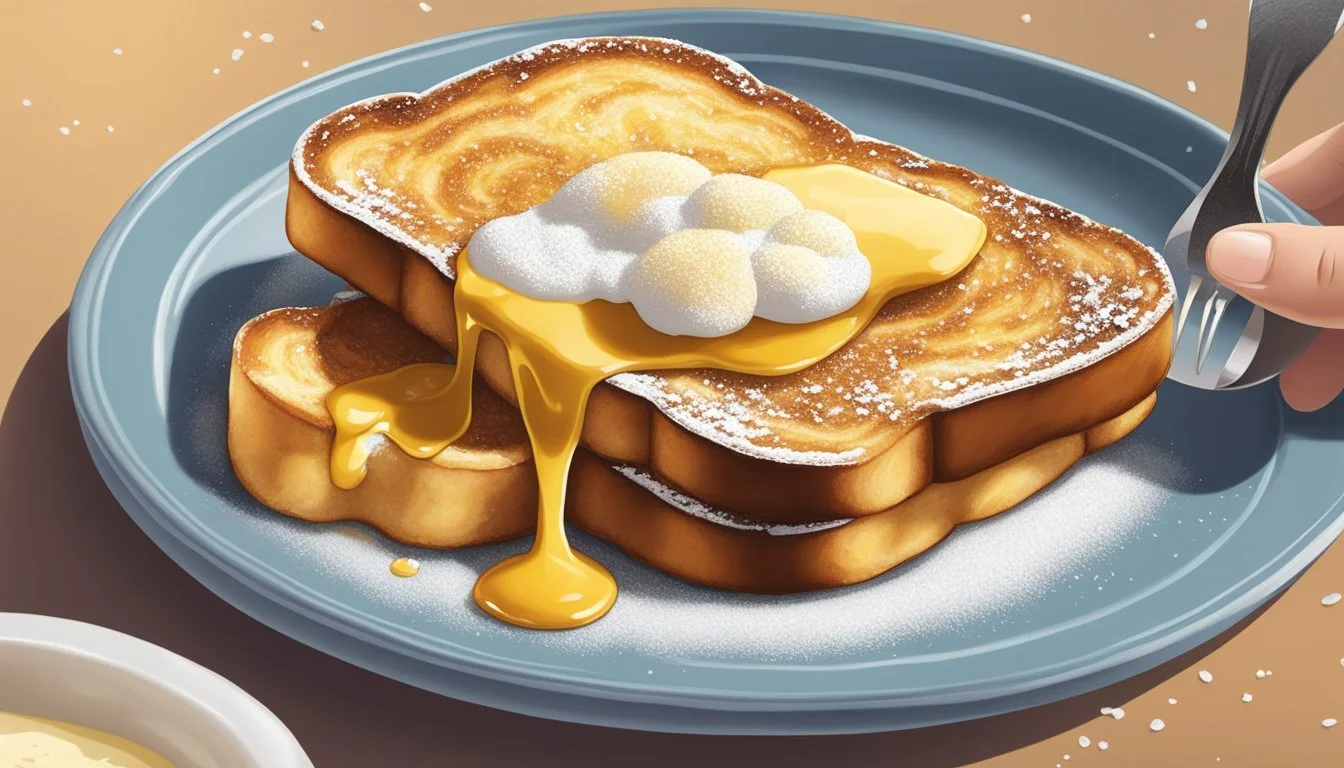How to Make a Classic Texas French Toast
Your Ultimate Guide
Texas French Toast takes the classic breakfast dish to new heights by offering a heartier, thicker version of the beloved morning staple that is sure to satisfy any appetite. Characterized by the use of thickly sliced bread (What wine goes well with bread?), typically Texas Toast, this recipe combines the sweet flavors of vanilla and cinnamon with the rich textures of bread soaked in an egg mixture, providing a deliciously crisp exterior and a soft, custardy interior.
To craft an authentic Texas French Toast, one must pay close attention to detail. The bread chosen is paramount; it must be thick enough to withstand soaking without falling apart, yet able to absorb the flavors of the egg mixture. The process involves whisking together eggs, milk, and spices, then dipping the bread slices to coat them thoroughly, ensuring each piece is soaked but not soggy.
Cooking Texas French Toast requires a delicate balance of heat and time. A skillet or griddle is typically preheated to a golden medium temperature, and the toast is cooked until it reaches a perfect golden-brown crispness. The result is a decadent dish, often served with a dusting of powdered sugar, a drizzle of maple syrup, or even a dollop of fresh whipped cream — a true convergence of simple ingredients coming together to create a delightful breakfast experience.
Gathering Ingredients
When making Texas French Toast, selecting the right ingredients is crucial for achieving the classic taste and texture. Each component, from the bread to the egg mixture and the sweet and flavorful additions, plays an integral role.
Choosing Bread
The foundation for Texas French Toast is the bread. Ideal choices include:
Texas toast — Thick-sliced white bread that absorbs the egg mixture well without falling apart.
Brioche — A slightly sweet, rich bread that adds a luxurious element.
French bread or Italian bread — These will give a chewier texture, suitable for those who prefer a heartier bite.
Whole wheat bread — A less traditional choice that provides a denser texture and a nuttier flavor.
Egg Mixture Essentials
The egg mixture is essential for the custard-like consistency of the French toast. The base of this mixture includes:
Eggs — Typically, one egg per two slices of bread.
Milk — Whole milk is preferred for its creaminess, but low-fat milk can be used for a lighter version.
Cinnamon — A must-have spice for adding warmth to the dish.
Sweet Additions
Sweetness balances the richness of the egg mixture and enhances the overall flavor. Sweeteners include:
Granulated sugar or brown sugar — Either can be used to add depth of flavor.
Cinnamon sugar — A blend of cinnamon and sugar sprinkled on the bread can create a caramelized crust.
Flavor Enhancers
For an aromatic touch to the French toast, these enhancers are not to be overlooked:
Vanilla extract — Even a small measure can significantly uplift the aroma and flavor profile.
Cinnamon, included in the egg mixture, acts as both a foundational spice and flavor enhancer.
By carefully selecting each ingredient, one sets the stage for a delectable Texas French Toast experience.
Preparing the French Toast
The process of making French Toast involves creating a rich custard, thoroughly soaking bread slices, and then carefully frying them to achieve a golden brown perfection.
Making the Custard
One begins by preparing a custard mixture that serves as the base of French Toast. They should whisk together eggs, milk, and a sweetener such as sugar or vanilla, along with a generous sprinkle of cinnamon. A consistent, lump-free mixture is crucial for even coating of the bread.
Ingredients for custard:
Eggs
Milk
Cinnamon
Sugar or Vanilla (optional)
Soaking the Bread
Next, one should select thick slices of bread, which stand up better to soaking without disintegrating. Each slice needs to be dipped in the custard mix, placed in a shallow bowl or dish, ensuring each side of the bread fully absorbs the mixture. It's important to avoid soaking the bread for too long, as it may become soggy.
Steps for soaking:
Dip each slice into the egg mixture.
Ensure both sides are well-coated.
Cooking on the Skillet
For cooking, use either a non-stick skillet or an electric griddle. Heat should be maintained at a medium to low heat to allow the bread to cook through without burning. Cook each soaked slice until it turns golden brown on each side, which typically suggests the dish is perfectly baked through. One should aim for a crispy exterior with a soft, custard-like interior.
Cooking instructions:
Heat the skillet or griddle to a moderate temperature.
Cook until each side is golden brown.
Serving Suggestions
While Texas French Toast offers a heartening experience on its own, the right toppings and presentation can elevate this classic dish to an impressive brunch (What wine goes well with brunch?) staple.
Accompanying Toppings
To complement the rich flavor of Texas French Toast, consider a variety of toppings. A drizzle of real maple syrup is traditional and adds a deep, sweet flavor that penetrates the toast. For those looking to embellish further, here are additional suggestions:
Powdered sugar: A light dusting adds a touch of sweetness and a visually pleasing aesthetic.
Fresh fruit: Berries, sliced bananas, and other fruit offer a refreshing contrast and a burst of natural flavor.
Whipped cream: Adds a creamy and luxurious element that works well with the toast's texture.
Jams: Various jams can introduce a tart or sweet nuance that caters to individual preferences.
Presentation Tips
The presentation of Texas French Toast can make it all the more inviting. Here are a few tips to enhance its visual appeal:
Contrast: Arrange colorful berries or fruit around the toast to create visual interest.
Layering: Strategically place whipped cream or a scoop of jam atop the toast, allowing for a professional, yet homely look.
Texture: Sprinkle powdered sugar through a sieve for an even and fine coating that suggests a handcrafted touch.
Remember, the key is to balance flavors and colors for a presentation that pleases both the palate and the eye.
Variations and Alternatives
Texas French Toast can be adapted to suit various tastes and dietary requirements. The classic recipe offers a rich foundation for creativity, and can easily be modified for different occasions, from a quick brunch to an elaborate dinner.
Creative Twists on the Classic
Pumpkin French Toast: Adding pumpkin puree and a blend of autumnal spices such as nutmeg and clove can transform the profile of Texas French Toast for a seasonal twist.
Eggnog French Toast: For a festive variation, substitute milk with eggnog in the custard mixture and complement with a dusting of nutmeg.
French Toast Bake: This is a perfect dish for accommodating multiple guests. Layer Texas toast in a baking dish, pour over the custard mixture, and bake until golden brown. It can be prepared overnight for an effortless breakfast or brunch.
Cinnamon Bread French Toast: For added flavor, use cinnamon bread instead of plain Texas toast to infuse the dish with a warm, spicy aroma.
Air Fryer French Toast Sticks: Slices of Texas toast can be cut into sticks and cooked in an air fryer for a quick and healthier option that crisps the outside while keeping the inside soft.
Add-ins and Toppings: Incorporate raisins or pecans into the custard mixture or sprinkle them on top for a crunchy texture contrast.
Dietary Accommodations
Gluten-Free Alternatives: For those with gluten sensitivities, gluten-free bread can replace Texas toast without compromising the integrity of the dish.
Dairy-Free Variations: Almond, soy, or oat milk can substitute for dairy milk, and vegan butter or coconut oil can be used to fry the toast for a dairy-free version.
Vegan French Toast: Utilize plant-based milk and egg alternatives such as flaxseed or chia eggs to cater to vegan preferences.
Low-Sugar Options: Reducing or omitting sugar in the batter and opting for fresh fruit or sugar-free syrup as toppings can make the dish suitable for those watching their sugar intake.
Each alteration retains the essence of the beloved French toast while providing alternatives to accommodate different dietary needs or simply to enjoy a novel take on the classic breakfast dish.
Time and Technique
Preparing Classic Texas French Toast is a balance of timing and skill to achieve the iconic golden-brown exterior with a soft, custard-like interior. Precision brings this beloved dish to its fullest potential.
Quick French Toast Tips
One must preheat their cooking surface—be it a skillet, griddle, or electric skillet—to a medium or medium-low temperature, around 325 degrees F. The objective is to cook the French toast for approximately 1.5 to 2 minutes per side. This is essential to reach a golden-brown finish without burning.
Skillet/Griddle: Preheat to 325-350 degrees F.
Wire Rack: Use to keep toast warm in oven.
Baking: Optional step for larger batches or crispier texture.
A wire rack placed inside an oven set to a low temperature can keep completed slices warm and prevent sogginess while the rest are being prepared.
Approaching the Perfect Texture
Achieving the ideal texture for Texas French Toast involves soaking each slice of bread long enough to saturate it with the egg mixture but not so long that it falls apart. After soaking, transfer the bread to the hot surface. They should sizzle gently upon contact, signaling the start of the cooking process.
Soak Time: Brief yet thorough.
Cook Time: 1.5 to 2 minutes per side.
If one prefers to bake their French toast as a finishing touch, they could do so for a few minutes at around 375 degrees F after frying, to ensure a crisper edge. The entire process, including prep and cook time, should take no more than 15 minutes.
Advanced Topics
When crafting the perfect Texas French Toast, the subtleties of technique and ingredient choice are key. This section delves into the advanced concepts that elevate a simple breakfast dish into a culinary experience.
Understanding the Bread's Role
Choosing the right bread is crucial for Texas French Toast. Texas toast bread, known for its thick slices, provides a sturdy base that can absorb the custard without disintegrating. Stale bread is often preferred as its dryness allows for better absorption of the custard without becoming overly soggy.
The Science of Custards
The custard mixture for French toast is a delicate balance of eggs and milk or cream. When soaked, the proteins in the egg create a stable structure as they coagulate under low heat, resulting in a creamy texture. It's important to cook at a temperature that is high enough to set the custard but low enough to prevent burning.
Nutritional Aspects
Regarding nutrition information, Texas French Toast can vary. Making the custard with whole milk adds richness but also calories. One can opt for alternatives like almond or soy milk to alter the nutritional profile. To keep saturated fats minimal, cooks might use cooking sprays instead of butter for cooking.
Nutrition Component Typical Content Calories High Carbohydrates Moderate to High Protein Moderate Fats Varied
Keeping French Toast Warm
To keep French Toast warm without compromising texture, one can use a wire rack placed in a warm oven. This method allows for air circulation around the toast, preventing it from becoming soggy, which is especially important when serving multiple pieces or catering to a large group.
Beyond Breakfast
Texas French Toast transcends the traditional breakfast table and seamlessly integrates into lunch, dinner, and brunch menus. Offering flexibility to the day’s meals, this delectable dish can be customized to suit various tastes and dining occasions.
French Toast for Any Meal
French Toast isn't confined to mornings. It makes an exciting centerpiece for brunch, a sweet twist on lunch, or even a comforting choice for breakfast for dinner. For families looking to shake up their meal routine, Texas French Toast can be paired with a range of sides from crispy bacon to fresh fruit or jam, making it a versatile option any time of the day.
Savory Variations
Moving away from sweet profiles, Texas French Toast can be reinvented with savory toppings. An evening version might incorporate a syrup reduction glaze or a side of crispy bacon, transforming it into a satisfying dinner option. A lunchtime rendition could be topped with a fried egg or served alongside a salad, expanding its typically sweet boundaries into savory territory.
Prolonged Enjoyment
After indulging in the rich flavors of Texas French Toast, one might have leftovers or a desire to enjoy this treat later on. Knowing the proper methods for storing and reheating can significantly enhance its longevity and taste.
Storing Leftovers
To maintain the quality of Texas French Toast, it should be stored properly. Leftovers should be allowed to cool to room temperature before being placed in the refrigerator. For best results, they should be tightly wrapped in aluminum foil or placed in an airtight container. Stored this way, the French toast can last for up to three days. If one needs to keep it for an extended period, freezing is a viable option. French toast can be frozen by wrapping individual slices in foil and then placing them into freezer bags. When properly stored, they can be kept in the freezer for up to two months.
Reheating for Best Results
Reheating Texas French Toast correctly is key to enjoying its optimal texture and taste. To maintain its quality, the toast should be reheated on low heat to prevent it from drying out. An oven or toaster oven set to 350°F (175°C) works nicely for warming it evenly. Arrange the toast in a single layer on a baking sheet, and heat for 5 to 10 minutes or until it is thoroughly warmed through. If one is strapped for time, a microwave can be used, but it may alter the texture slightly. For those who have stored their toast overnight in the fridge, letting it sit on the counter for a few minutes before reheating can improve the warmth distribution.
Enhancing Your Cooking Skills
Mastering the art of Texas French Toast involves honing some key kitchen techniques for consistency while also making the process family-friendly, especially when cooking with kids. This section guides you through effective methods for crafting a delicious breakfast and engaging your little helpers in the process.
Techniques for Consistency
Choosing the Right Equipment: A large nonstick skillet or an electric griddle is essential for achieving evenly cooked Texas French Toast. The consistent heat distribution helps prevent sticking and allows for a golden-brown finish.
Heat Control: It's crucial to maintain a medium heat since too high will burn the toast, and too low will not provide the delightful crispiness expected in the dish.
The Whisking Process: Properly whisking the egg mixture ensures that each slice of French toast is saturated with the same amount of flavor and richness.
Use of a Wire Rack: Placing the soaked bread on a wire rack before frying allows excess egg mixture to drip off, preventing a mushy texture.
Cooking with Kids
Allowing children to participate in the kitchen is a great way to teach them cooking skills and build family memories. Here are specific steps they can assist with:
Whisking: Kids can help whisk together the eggs, milk, and cinnamon, instilling in them the importance of thoroughly mixing ingredients.
Dipping Bread: They can dip each piece of bread into the egg mix, ensuring that each side is coated—an excellent way to teach them about even saturation and patience to avoid sogginess.
Assembly: Involving them in placing the dipped bread on the wire rack introduces the concept of preparation and organization in cooking.
Final Touches
The final touches elevate the simple Texas French Toast to a visually appealing and tantalizing dish. Thoughtful garnishes and meticulous presentation are key for the ultimate breakfast experience.
Garnishes and Presentation
A sprinkle of powdered sugar dusted lightly over the golden-brown toast adds a hint of sweetness and a sophisticated visual effect. Berries such as strawberries, blueberries, or raspberries offer a fresh, tart contrast to the rich toast and can be artfully arranged on top or beside the toast for a pop of color.
Adding a dollop of whipped cream can provide a creamy texture and a lovely visual appeal. For those who prefer a fruity element, a spoonful of quality jam or a selection of fresh fruit can complement the dish with additional flavors and vibrant colors. The careful placement of these ingredients not only enriches the taste but also ensures a presentation that pleases the eye.
Conclusion
Texas French Toast stands out with its thick and fluffy bread, making for a delightful breakfast or brunch option. It combines simplicity and flavor, which often places it high on the list of comfort foods. This classic recipe can be enjoyed with a variety of toppings, such as fresh fruit, syrup, powdered sugar, or even whipped cream, allowing for a customizable and satisfying experience.
The thickness of Texas Toast is ideal for creating a custardy interior and a slightly crisp exterior. The key steps involve soaking the bread sufficiently but not excessively, ensuring that it is neither dry nor soggy. The use of standard ingredients like eggs, milk, cinnamon, and vanilla extract makes it an easily approachable dish for cooks of all skill levels.
Remember:
Consistent Heat: Maintaining a medium to medium-low heat allows the French toast to cook thoroughly without burning.
Customizable: Tweak the amount of cinnamon or vanilla to cater to personal taste.
Soaking Time: Each bread piece should be soaked well, but refrain from letting it turn soggy.
Patience is Crucial: Give the bread ample time to cook on each side to achieve the perfect golden-brown finish.
With these tips and a straightforward approach, anyone can create a Texas French Toast that is not just delicious but also boasts the heartiness expected from such a beloved dish.
Additional Resources
This section provides curated pathways for food enthusiasts to broaden their culinary experience beyond Texas French Toast and to discover products that can enhance their cooking endeavors.
Exploring Related Dishes
When enthusiasts want to expand their breakfast repertoire, they can explore pancakes and waffles as alternatives. Each dish offers unique textures and flavors that are beloved in breakfast culture. They may also explore other homemade French toast recipes using different bread types, such as baguette or brioche bread, which are known for their ability to soak up the custard without falling apart. For an authentic touch, topping these dishes with pure maple syrup can elevate the taste experience.
Pancakes: Explore recipes using buttermilk for a tangy flavor and fluffy texture.
Waffles: Experiment with waffle irons of varying patterns for a fun twist.
Homemade French Toast: Make use of rich brioche bread to ensure a perfectly tender French toast.
Affiliate Products and Reviews
For those looking to improve their French toast game or experiment with related recipes, the following products come highly recommended and have been reviewed for quality:
Product Type Description Affiliate Link Bread Brioche and baguette are optimal for French toast. Best Bread for French Toast Syrup Pure maple syrup is an indulgent topping choice. Buy Pure Maple Syrup Cooking Equipment Electric skillets and griddles are key for even cooking. Shop Electric Skillets
Connoisseurs can find further details and reviews on these products through associated affiliate links. Not only do these reviews provide valuable insights, but they also guide consumers to make informed purchasing decisions.
Feedback and Engagement
In the world of culinary delights, especially when it comes to notable dishes like Texas French Toast, feedback and engagement play vital roles. Families and restaurants alike can benefit from sharing their culinary experiences and connecting with a broader community to enhance the enjoyment and craft of cooking.
Sharing Your Creations
Chefs and home cooks are encouraged to share pictures and recipes of their Texas French Toast creations on social media platforms, tagging their family members or the restaurant where they enjoyed this dish. For restaurants, this serves as a form of customer-generated promotion, while families can cherish the joy of shared experiences through visual memories.
Platforms to Share:
Instagram
Facebook
Pinterest
Tagging Tips:
Mention family members or friends.
Use hashtags like #TexasFrenchToast or #BreakfastBliss.
Connecting with the Community
Joining cooking forums and local cooking classes can be tremendously valuable for gaining new insights and techniques. Families can exchange cherished recipes, while restaurants often use such platforms for gathering customer feedback and suggestions.
Community Engagement Methods:
Participate in cooking forums such as Reddit's r/Cooking.
Offer or attend local cooking workshops.
Feedback Channels: Restaurants can engage with their customers through:
Comment sections on social media posts.
Online review platforms like Yelp or Google Reviews.
About the Author
The author of the "Classic Texas French Toast" recipe is widely regarded for expertise in the culinary arts, with a strong focus on breakfast dishes that bring comfort and joy to family kitchens. Specializing in recipes that are both delectable and approachable, she seamlessly blends tradition with a touch of modern flair.
Her culinary journey began in the family kitchen, where the aromas of cinnamon, vanilla, and toasted bread were a quintessential part of weekend mornings. This early exposure instilled in her a love for cooking that is deeply entrenched in family values and traditions.
Professional Background:
Years of Experience: Spanning over a decade in the culinary field.
Specialization: Breakfast and brunch recipes that cater to diverse palates.
Philosophy: Cooking should be enjoyable and recipes, easily replicable at home.
Recipe Development:
Focus: Ingredient integrity and clear, step-by-step guidance.
Method: Hands-on testing and refining to ensure foolproof results.
Culinary Influence:
Inspirations: Rustic, homemade fare and modern fusion cuisine.
Mentorship: Draws from collaboration with fellow chefs and family elders.
She believes that a good recipe, like the Classic Texas French Toast, should not just satisfy hunger but also create an experience that strengthens family bonds. Her approach to cooking is characterized by precision and simplicity, ensuring that anyone, regardless of their skill level, can recreate her recipes with the same success.
Disclaimers and Disclosures
In the effort to provide a clear understanding of the Texas French Toast preparation process, the following disclaimers and disclosures are provided for transparency and information accuracy:
Nutrition Information:
The nutritional content of Texas French Toast can vary significantly based on the ingredients used. Recipes can differ in terms of the type of bread, amount of sugar, milk, and butter, which impact the calorie count and nutritional profile.
Calories: Texas Toast is typically denser than regular bread, leading to a higher calorie content per serving.
Sugar: Sweeteners in the recipe affect the dish's sugar content. Moderation is key.
Milk: Different types of milk (whole, skim, plant-based) alter fat and protein levels.
Product Affiliate Links:
This article may include affiliate links to products required for making Texas French Toast. If readers choose to buy products through these links, the publication may earn a commission. However, the integrity of the recommendations remains unaffected, as only products believed to be of good quality are suggested.
Transparency: Any affiliate links are disclosed as per the publication's policy.
Selection: Products are selected based on quality and relevance to the recipe.
Cookware Usage and Safety:
The cookware recommended for preparing Texas French Toast, like electric skillets or frying pans, should be used in accordance with the manufacturer's safety guidelines. One must ensure that all appliances are in good condition to prevent accidents.
The content provided is meant to be educational and does not substitute professional dietary advice. Always consider individual dietary restrictions and preferences when preparing food.

